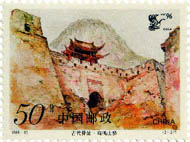The Colorful History of Chinese Stamps
IN August 1982, the First Congress of the All-China Philatelic Federation convened in Beijing, and the Chinese Ministry of Post and Telecommunications issued a stamp sheetlet in commemoration. The stamp motif depicts an ancient courier galloping on horseback, while in the background wild geese fly in graceful formation. Wild geese are migratory birds, and every autumn they can be counted on to set off on their thousand-kilometer migration southward to warmer climes. With no better means of communication, ancient Chinese who wished to send messages over great distances took advantage of the birds' north-south odyssey by attaching tiny scrolls to their feet. The phrase, "hongyan chuan shu" (wild geese deliver messages), has survived the millennia to become one of the oldest idioms in the modern Chinese language.
The Wild Goose as Messenger
The earliest record of "hongyan chuan shu" can be found in Chronicles of the Han Dynasty: The Biography of Su Wu. It reports that during the Han Dynasty (206 BC-AD 220), Su Wu traveled to Xiongnu (Hun) as a Han imperial envoy to the Western Regions, but was detained along the way by the Xiongnu khan and exiled to Beihai to herd sheep.
When Han Emperor Zhaodi succeeded to the throne, he tried to maintain good relations with Xiongnu, and again sent an envoy to ask for Su Wu's return. He was told, however, that Su had died. Only later did the envoy learn the truth from a member of Su Wu's entourage. He confronted the Xiongnu khan, and using a ruse of his own, claimed that the Han emperor had caught a wild goose on whose leg was attached a letter from Su Wu, informing him that he was herding sheep near a wetland. Believing his lie to be exposed, the khan apologized to the envoy and released Su Wu.
Su Wu's story may have been no more than a legend, but an actual, documented instance of a wild goose serving as a courier dates back to 1274, when a Mongol envoy during the Southern Song Dynasty (1127-1279), Hao Jing, did exactly that. When the powerful Mongol cavalry swept across its northern territory and pushed toward the Yangtze River, the Southern Song Prime Minister Jia Sidao pledged obedience to Kublai Khan and offered annual tribute in return for peace. Kublai Khan agreed and withdrew his troops, sending Hao Jing to the Southern Song to negotiate a formal peace agreement.
Upon returning home, Jia Sidao bragged of his "heroic leadership" in "defeating" the Mongol army, mentioning nothing of a peace deal. When Hao Jing arrived at Zhenzhou (now Yizheng, Jiangsu), he first contacted Jia Sidao, who detained the Mongol envoy immediately fearing the truth would be revealed.
Hao Jing was imprisoned in Zhenzhou for 16 years. He wrote a letter to the Song emperor every month, begging for a meeting, but all were intercepted by Jia Sidao. Finally, Hao raised and trained a wild goose and wrote a letter on a piece of silk, which he attached to the goose's leg. He reported his situation, and at the end of the letter, he wrote: "This bird was let go on the first day of the ninth moon in the 15th year of the Zhongtong Reign (1274). Anyone who catches it should not kill it. The letter is written by Imperial Envoy Hao Jing in the New Hall of the Zhenzhou Loyal and Gallant Army Barrack."
Hao Jing released the bird in the autumn, and the next spring the Mongols received the letter and presented it to Kublai Khan, who immediately dispatched his troops to attack the Southern Song. When the Mongol troops approached the Southern Song capital Lin'an (today's Hangzhou), Jia Sidao's lie was exposed. Hao Jing was released and returned to the Yuan capital Dadu (now Beijing). His 16-year imprisonment had ruined his health, however, and he died soon after at the age of 53. But he had written many letters to the Song imperial court during his long captivity, amounting by some estimates to hundreds of thousands of characters, in addition to hundreds of volumes of articles, poems and reading annotations. In 1279, the Yuan Dynasty overthrew the Southern Song and united China. Hao Jing's "wild goose letter" was later preserved in the Yuan imperial archive.
 |
| The 1995 Jiming Mountain Post Town stamp. |
|
